Gundog training: It’s possible to conduct gundog training at home even with no prior experience.
Win CENS ProFlex DX5 earplugs worth £1,149 – enter here
How to teach spaniels to head in the right direction
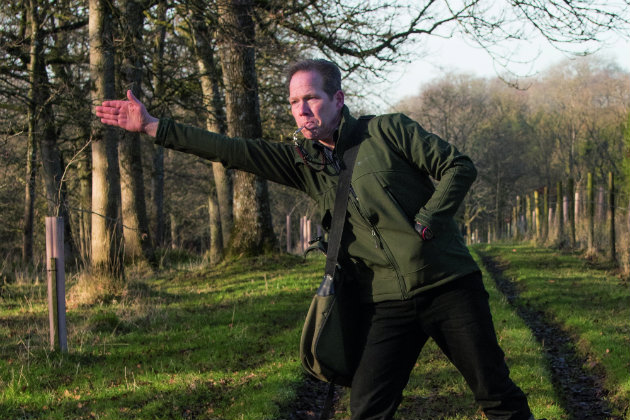
Some people question whether you need to teach a gundog to go left and right; unless you just go beating it can be a useful skill to teach spaniels (and other gundogs). If you plan to shoot over your dog or want it to pick-up, there will be times when being able to re-direct it on to a retrieve, especially a runner, will be helpful. If you plan to enter any working tests you will almost definitely need to handle your dog.
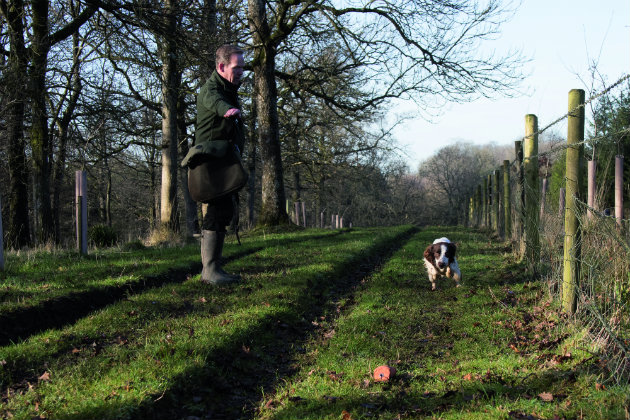
Dolly, the young springer, immediately went to the dummy and brought it back, reading Neil’s signals
Starting to teach spaniels
I like to start with left and rights. This is simply because during their hunting exercises I sometimes use my hands to direct them when they are quartering and when I want them to enter a certain piece of cover, and therefore they are used to “following” my hand signals. At Twistmount I am lucky in that I have areas that are set out for particular exercises — I use a track with a fence line running along the back of it to do all my handling training. The fence helps the dogs to run in a straight line, which is ultimately what we want to achieve.
I have been having a few problems with Dolly, my young springer bitch, that are not uncommon when initially starting out with left and rights. Before I could even begin to start this exercise, Dolly had to be totally steady to thrown dummies and maintain a “sit-stay”. I sat her up alongside the fence and threw a dummy out to the right; at this stage I only throw the retrieve out a short distance from the dog.
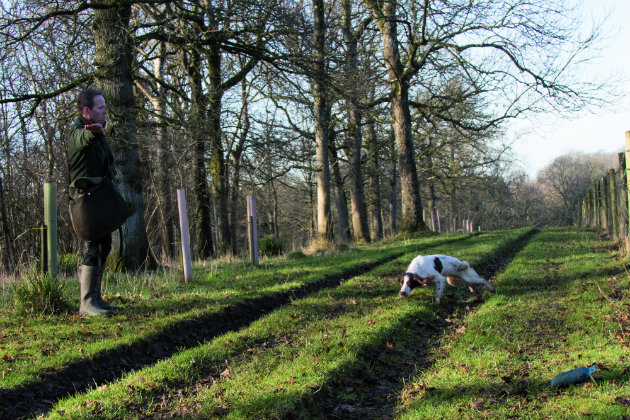
In directional training it is the distance that the handler is from the dog that is the most important lesson
The hand signal has to be exaggerated because eventually the dog may be working at a distance, so I take a step to the right and push my arm out to the right at around shoulder height and hold it there. Dolly immediately went out to the dummy and brought it back — success! A common mistake that novice trainers make is they think that throwing the dummy farther away from the dog is the key to directional work, but it is the distance that the handler is from the dog that is the important lesson.
The chances are that in the shooting field you will be re-directing your dog when it is at a distance from you, so this is the aspect that you should work on and this is where it all went wrong with Dolly. I set her up again and moved only a few steps farther away from her; the dummy was about the same distance from the dog. As soon as I sent her, she came towards me before turning back towards the retrieve. This is not what I want her to do; she needs to learn to go out at right angles to my signal.
The solution was pretty easy — next time I shortened the distance between me and the dog and sent her again. This time she turned immediately to the right and picked the dummy. I will take things a little bit slower with her. Over the next few weeks or so, I will gradually build up the distance but keep the dummy close to her, which will help to build up her confidence.
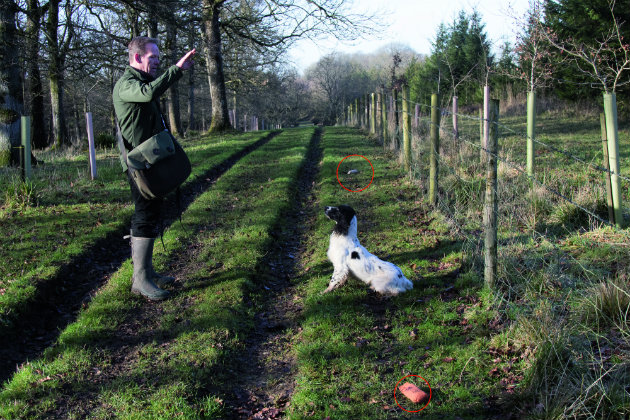
Using two dummies, with the left one farther away than the right, reinforces Logan’s training
Training the other springer
Logan picked up an injury during the shooting season so I haven’t done quite as much with him. After working on his steadiness I have been using two dummies, which has not only reinforced this aspect of his training but also means that I can work on two exercises at once. Initially, I always make the task as easy as I can for the dog; I want him to succeed as often as possible. (Continued below) …
When teaching the right-hand signal, I put the left dummy a bit farther away from Logan and the right-hand one closer, which serves two purposes. The first is that the left-hand dummy serves as a distraction and, second, if he does break towards the wrong one (left), I have a chance to stop him before he reaches the dummy and rewards himself. The dummy on the side I want to send him will be the more tempting. If he follows my hand signal he will see the dummy and head in that direction.
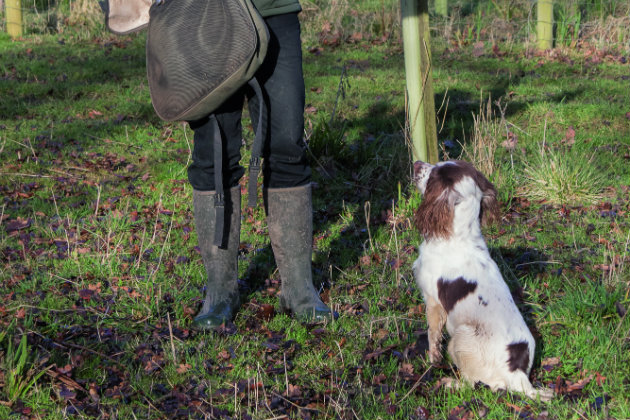
Neil varies the routine – such as sitting the dog and waving his arms about – to stop Logan anticipating
With both spaniels I’ve been concentrating on sending them in one direction until they have fully learned that lesson, then I swap sides. It is important not to let the dogs second-guess you and anticipate your command. I prevent this by constantly changing the length of time I take before sending the dog; sometimes I will walk out to my position, wait a minute or so, then walk back to the dog and pick up the dummy myself — keep them guessing. Sometimes a dog learns that as soon as you put out your arm you are going to send it, so I will also sit the dog up in front of me and wave my hands about, put them in my pockets, or get something out of my gamebag.
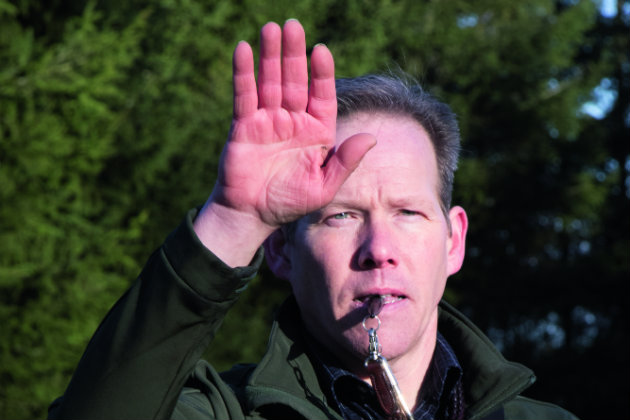
Neil holds up his hand, giving the “go back” signal
Teaching the Labrador the “back” command
My Labrador Remy is a very keen retriever and I have begun to incorporate the “back” command with some easy memory retrieves. It is important that any hand command you give should be clear and precise, especially with the retrieving breeds because they will be working at a far greater distance than a spaniel.
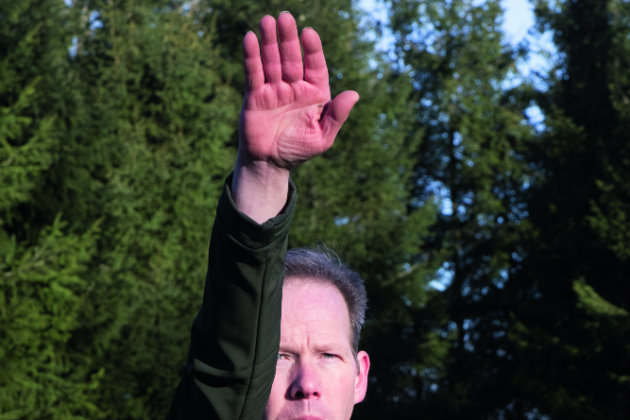
The exaggerated signal enables the gundog to see it
The biggest mistake novice trainers make is that they do not make the hand signal for the “go back” command clear enough. Quite often the hand will be level with the handler’s face and at a distance the dog has no chance of seeing it.
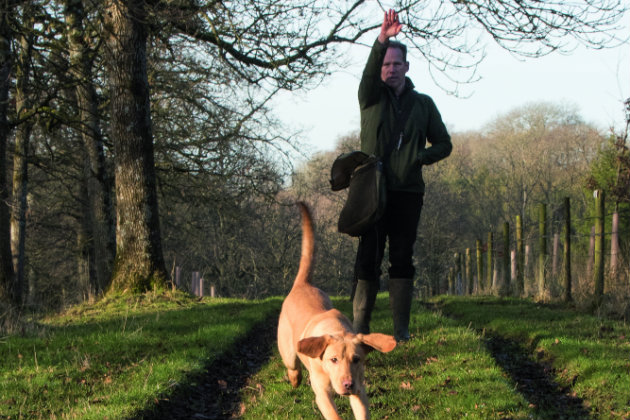
Giving the command, Neil pushes his hand away
The “back” command is probably the most important handling skill you can teach your gundog. It is an easy lesson and one that Remy learnt quite quickly. To start with, I walked him out on his lead and dropped a dummy, told him to leave it and walked him away. After about 15m I sat him up and carried on walking for a couple more metres, turned around, put my hand up to about shoulder height and to one side of my face. As I gave the “go back” command I pushed my hand up and away from me. This is a clear signal that, as things progress, Remy will be able to see from any distance, especially if the background behind me is dark and my hand will be highlighted.
Over the coming weeks I will be working on extending the distance that both I and the dummy are from the dog. With Remy I will be working on sending him in straight lines, which is why I like to use a track with a fence line to help guide him on his out runs.
Related Articles
Get the latest news delivered direct to your door
Subscribe to Shooting Times & Country
Discover the ultimate companion for field sports enthusiasts with Shooting Times & Country Magazine, the UK’s leading weekly publication that has been at the forefront of shooting culture since 1882. Subscribers gain access to expert tips, comprehensive gear reviews, seasonal advice and a vibrant community of like-minded shooters.
Save on shop price when you subscribe with weekly issues featuring in-depth articles on gundog training, exclusive member offers and access to the digital back issue library. A Shooting Times & Country subscription is more than a magazine, don’t just read about the countryside; immerse yourself in its most authoritative and engaging publication.








